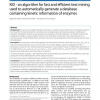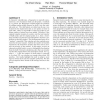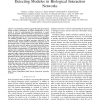314 search results - page 56 / 63 » A Comparison of Known Codes, Random Codes, and the Best Code... |
BMCBI
2010
13 years 7 months ago
2010
Background: The amount of available biological information is rapidly increasing and the focus of biological research has moved from single components to networks and even larger ...
WABI
2009
Springer
14 years 2 months ago
2009
Springer
Background: Frameshift mutations in protein-coding DNA sequences produce a drastic change in the resulting protein sequence, which prevents classic protein alignment methods from ...
CCS
2006
ACM
13 years 11 months ago
2006
ACM
In biometric identification, a fingerprint is typically represented as a set of minutiae which are 2D points. A method [4] to protect the fingerprint template hides the minutiae b...
IJBRA
2010
13 years 6 months ago
2010
—Accumulating evidence suggests that biological systems exhibit modular organization. Accurate identification of modularity is vital for understanding this organization. A recen...
BMCBI
2010
13 years 7 months ago
2010
Background: Sequence comparisons make use of a one-letter representation for amino acids, the necessary quantitative information being supplied by the substitution matrices. This ...



